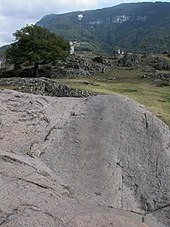Sliding stone
A slip stone , even slipping Rock, skid plate or slide called, is part of a fertility cult , the likes of the older literature and today's popular literature in the early history (for example, the megalithic culture ) is projected back. The term Kindlistein is sometimes used synonymously, but can also designate a stone as the place of origin of the children.
Women with an unfulfilled desire to have children sought out (and still seek here and there today) such slabs of rock that have been polished through long-term use. Occasionally sliding stones are associated with a cup stone .
Examples can be found in South Tyrol ( Taufers , Castelfeder , Lengstein am Ritten ), in Liguria , in Piedmont , in the Aosta Valley , in Valais , in Île-de-France , in Picardy , in Brittany and elsewhere.
literature
- Hans Haid : Myth and cult in the Alps: the oldest, old and current about cult sites and mountain sanctuaries in the Alpine region . Edition Tau; Bad Sauerbrunn 1990, ISBN 3-900977-08-9 .
- L. Rütimeyer: About shell and sliding blocks in the canton of Valais and elsewhere and their meaning. In: Swiss Archives for Folklore 28, 1928, pp. 145–192, especially pp. 180–186 (chapter bowl stones of sexual and cultic significance ).
- Yves Schumacher: Stone cult book Switzerland. A guide to the cult stones and stone cults. edition amalia, Bern 1998, ISBN 3905581-06-X , pp. 9-14 (chapter name stones ).
Individual evidence
- ↑ On Wallis see L. Rütimeyer: About shell and sliding blocks in the canton of Wallis and elsewhere and their meaning. In: Swiss Archives for Folklore 28, 1928, pp. 145–192, the respective Wikipedia articles on Italy and France.

